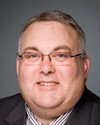Thank you, Mr. Chair.
To my two colleagues, I have four questions. Maybe you addressed my concerns partly or completely. If that's the case, repeat very briefly what you have already said, but maybe some parts of your answers will be new for the committee.
My first question is on your comments today, your objections. Are they new for the commission, or a reiteration? If they’re new, why? If they’re a reiteration, what can you add to what you have already said to the commission to convince it?
My second question is on how many other ridings are affected by your change. Chris, I think it's seven in your case. Could you just clarify that? Do you have the agreement of the affected colleagues? Did you try? What is your understanding of the consequences on these ridings if you don't have the agreement of your colleagues?
On the demographics, I'm very impressed that in Alberta the commission tried to stay within the 5%, plus or minus, while the law allows for the possibility of going up to 25%, plus or minus. Many commissions try to stay in the range of 10%, as is the case in my province. Maybe for Albertans it is very important to have equality of citizens, and too bad for taking communities into account.
We have these numbers in your case, but, Brian, could you explain how many people are affected by what you are proposing? I understand there is a discrepancy between the official census and what you see on the ground, but it will help us if we have numbers.
Finally, it's the size. I know size and access are not the same. I think that is what both of you are arguing. The commission would argue in your case, Chris, that the riding you have is 162,871 square kilometres, and what they are proposing is quite a lot less, 105,925 square kilometres. It's an argument they put in objection to what you proposed, I suppose.
Could you address that?






